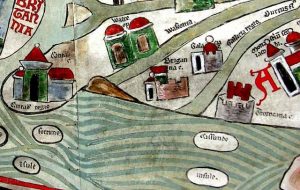THE SECRETS OF THE MOJAVE
(Or, The Conspiracy Against Reality)
Page # 10b
[7th edition]
Compiled by ‘The Group’ — Edited by ‘Branton’
Re-Edited 02,02,2020 for grammar and spelling – ‘Think’
 Sometime during the 12 century, a monastic chronicler in England by the name of “Gervase of Tilbury” recorded a strange account of two “children” who suddenly appeared near a small town near Bury St. Edmunds, England. The account was also recorded in the writings of several other chroniclers who lived at the time or sometime afterwards.
Sometime during the 12 century, a monastic chronicler in England by the name of “Gervase of Tilbury” recorded a strange account of two “children” who suddenly appeared near a small town near Bury St. Edmunds, England. The account was also recorded in the writings of several other chroniclers who lived at the time or sometime afterwards.
These include: William of Newbury — HISTORIA RERUM ANGLICARUM, written in Yorkshire, England (1136-1198?); Abbot Ralph of Coggeshall — CHRONICON ANGLICARUM; and also the chroniclers Giraldus Cambrensis and Walsingham. The account was more recently related in FLYING SAUCERS UNCENSORED, by Harold T. Wilkins (Citadel Press., New York, N.Y. 1955., pp. 97-98). From their combined accounts we can piece together the following bizarre story which the chroniclers swore to be true:
One warm, sunny day in the 12th century some farmers and other residents of the small town of Wolfpittes, England (some seven miles distant from the larger village of Burry St. Edmunds) were startled to see two young children wandering around, as if disoriented, in some ancient ‘pits‘ or ‘trenches‘ known to the locals as the ‘Wolf-Pitts‘ — after which the small village had taken it’s name. These excavations were ancient, but no one seemed to know when or by whom they were dug, but the consensus was that they were at least partly artificial, and very ancient. The most shocking thing about the children, which the residents of Wolfpittes encountered, was that they had skin which was olive-green in colour, yet the rest of their features were as human as the average Englishman.
The villagers attempted to communicate with the children but were unsuccessful, as they soon discovered that the young boy and girl spoke a language which was completely unfamiliar to the villagers. The townspeople had compassion on the children and took them to the village and offered them various different kinds of food, all of which they seemed unfamiliar with and which they refused. However, when they were shown some beanstalks, they took them greedily, but instead of opening the bean-pods, the children attempted to open the stalks themselves, as if they had been accustomed to opening stalks in this way (apparently a practice they had learned in the land from which they emerged).
Upon finding nothing in the stalks, the children began to weep. Unfortunately, the shock of entering our world was too much for the young boy, and even though he became partly acclimated to other forms of food, he nevertheless became weaker and weaker and finally died a few years afterwards. The young girl, however, adjusted quite well to her new surroundings. In fact she eventually grew into a mature, beautiful woman, and later married a gentleman from the nearby town of Kings Lynn. As time passed, her husband patiently instructed her in the complexities of the English language, and soon she was able to communicate fairly well, and the story she told of where she had come from and how she had arrived in our ‘world’ with her brother was even more incredible.
She told her husband that her people all had skin similar to hers, or rather similar to what her skin had once been like, as over a period of years and exposure to the outer elements the greenish tinge had left her. She described her world as a cavernous, subterranean country of enormous size, a country which went by the name of “St. Martin’s Land.” The land in which she lived was described as ‘twilight‘ in nature, yet there was a large underground river, on the other side of which there was another land more brightly lit.
One day, she and her brother were herding some type of underground animal when they heard something like the sound of ‘bells‘ emerging from one of the cave passages or tunnels which lined the perimeter of this underground land. Out of extreme curiosity, they entered this tunnel and followed the passage upwards for what could have been a few days, although in their underground land it is probable that they did not have any concept of what ‘day‘ or ‘night‘ was. After their long and weary journey up the steep incline they suddenly emerged into the brilliant sunlight of the British countryside. The change from their twilight world was dramatic, and the children walked around in the pits or trenches starved, half-blinded and disoriented. They shortly afterwards attempted to re-locate the small opening through which they had emerged, but were unable to do so, because of the blinding light. At about this point the farmers found the children and took them to the village.
A somewhat similar incident ‘may’ have been repeated in the small hamlet of Banjos (or Banos) Spain in August of 1887, several hundred years after the incident at Wolfpittes and several hundred miles distant. We state that it MAY have been repeated to some degree simply because there appears to be some confusion surrounding the Banjos account, apparently due to the possibility that some well-meaning researcher may have confused the two incidents, in essence attributing some of the events that in fact took place near Wolfpittes with the Banjos account.
Basically, the Banjos incident reportedly involved two children with greenish skin who emerged from a CAVERN near the town (not ‘pits’ or ‘excavations’), spoke an unknown language, and so on, although the details are sketchy. Some of the accounts of the Banjos incident repeat the Wolfpittes story almost verbatim, as if, as we said, someone somewhere mistakenly confused the two events, perhaps due to a lack of detail in the Banjos, Spain account.
Whatever the case, it seems that SOMETHING of this general nature also occurred in this Spanish hamlet, even though the exact sources of that particular story are more difficult to trace than are the sources for the Wolfpittes account. Paris Flammonde refers to this account in his book: THE AGE OF FLYING SAUCERS (Hawthorn Books, N.Y., p. 197), having learned it from an article in the September, 1967 issue of ORBIT Magazine, which in turn gave credit to an article in the Vol. XII, August 1967 issue of Dan Fry’s UNDERSTANDING Magazine. Fry claimed that he got the story from an article by John Macklin which appeared in the December, 1966 issue of GRIT Magazine. The account also appears in John Macklin’s book STRANGE DESTINIES (Ace Books., N.Y.); Jacques Bergier’s LES EXTRA- TERRESTRES; and the July 22, 1970 issue of the British periodical ‘WEEKEND’.
There are those who believe that similar cavern systems exist below the Southwest United States, and that the Dulce base in New Mexico was originally an entrance to one of these ancient underground kingdoms. Sources say that the humans, possibly the ancestors of the Pueblos, once ruled this underground kingdom. One abductee reported an “abduction” wherein he saw himself traveling in a craft through an immense cavern below the Grand Canyon. In one end of the cavern were the “ruins” of an ancient city, and in one of the walls he could see what appeared to be an elevator type of device that ascended the wall and disappeared through the roof.
